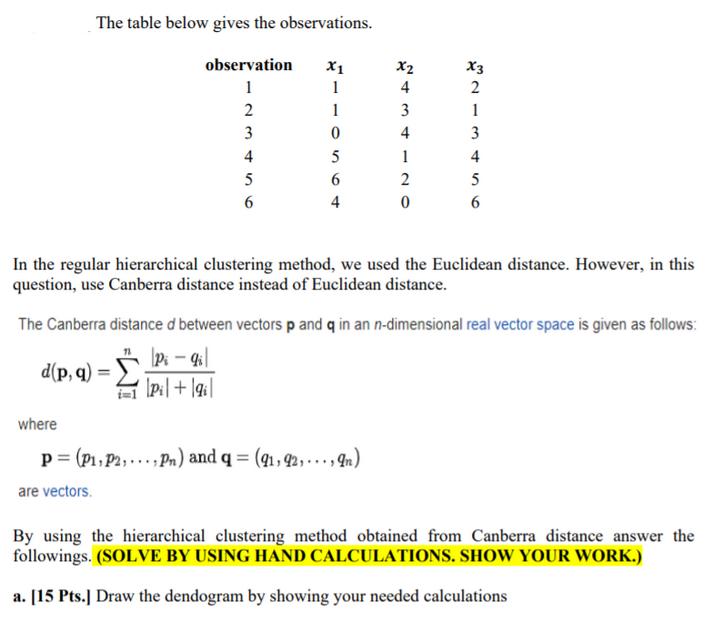Question
The table below gives the observations. observation 1 2 23 d(p, q) = 3 4 456 X1 1 1 0 5 6 4 x2

The table below gives the observations. observation 1 2 23 d(p, q) = 3 4 456 X1 1 1 0 5 6 4 x2 4 3 where p = (P, P2,..., Pn) and q = (91, 92,..., In) are vectors. 4 120 0 421345 X3 In the regular hierarchical clustering method, we used the Euclidean distance. However, in this question, use Canberra distance instead of Euclidean distance. 6 The Canberra distance d between vectors p and q in an n-dimensional real vector space is given as follows: Pi - 9 F i=1 Pi|+|9i| By using the hierarchical clustering method obtained from Canberra distance answer the followings. (SOLVE BY USING HAND CALCULATIONS. SHOW YOUR WORK.) a. [15 Pts.] Draw the dendogram by showing your needed calculations
Step by Step Solution
3.42 Rating (158 Votes )
There are 3 Steps involved in it
Step: 1

Get Instant Access to Expert-Tailored Solutions
See step-by-step solutions with expert insights and AI powered tools for academic success
Step: 2

Step: 3

Ace Your Homework with AI
Get the answers you need in no time with our AI-driven, step-by-step assistance
Get StartedRecommended Textbook for
Applied Regression Analysis And Other Multivariable Methods
Authors: David G. Kleinbaum, Lawrence L. Kupper, Azhar Nizam, Eli S. Rosenberg
5th Edition
1285051084, 978-1285963754, 128596375X, 978-1285051086
Students also viewed these Computer Network questions
Question
Answered: 1 week ago
Question
Answered: 1 week ago
Question
Answered: 1 week ago
Question
Answered: 1 week ago
Question
Answered: 1 week ago
Question
Answered: 1 week ago
Question
Answered: 1 week ago
Question
Answered: 1 week ago
Question
Answered: 1 week ago
Question
Answered: 1 week ago
Question
Answered: 1 week ago
Question
Answered: 1 week ago
Question
Answered: 1 week ago
Question
Answered: 1 week ago
Question
Answered: 1 week ago
Question
Answered: 1 week ago
Question
Answered: 1 week ago
Question
Answered: 1 week ago
Question
Answered: 1 week ago
Question
Answered: 1 week ago
Question
Answered: 1 week ago
Question
Answered: 1 week ago
View Answer in SolutionInn App



